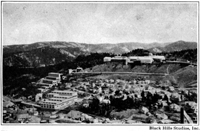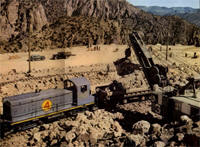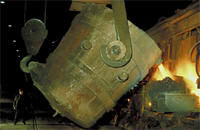|
GENERAL JOHN D. McINTYRE
A Biographical Sketch of General
John D. McIntyre from Representative Citizens of Seattle and King
County, Washington, pub. 1903
 There is no man in King County
whose life, if it were written in full here, would make so thrilling a
romance as that of Brigadier General J.D. McIntyre, of Seattle. He is
fifty-one years old [in 1903], by profession a mining engineer, and
until 1890 had lived almost continuously on the outskirts of
civilization. His life has been part of the history of many of our
western mining camps. He is a crack shot, and has had more sanguinary
encounters with men and wild beasts than could be recounted in a
volume. It may be said of him that he does not know the sense of fear.
For the past eleven years [as of 1903] he has settled down to a quiet
home life, has acquired a large fortune and lives in his own beautiful
home overlooking Lake Union, in Seattle. A visit to his home on Lake
Union is well worth anyone’s while. The originality of the
architecture of the house and grounds is a reflex of the character of
the man. There is no man in King County
whose life, if it were written in full here, would make so thrilling a
romance as that of Brigadier General J.D. McIntyre, of Seattle. He is
fifty-one years old [in 1903], by profession a mining engineer, and
until 1890 had lived almost continuously on the outskirts of
civilization. His life has been part of the history of many of our
western mining camps. He is a crack shot, and has had more sanguinary
encounters with men and wild beasts than could be recounted in a
volume. It may be said of him that he does not know the sense of fear.
For the past eleven years [as of 1903] he has settled down to a quiet
home life, has acquired a large fortune and lives in his own beautiful
home overlooking Lake Union, in Seattle. A visit to his home on Lake
Union is well worth anyone’s while. The originality of the
architecture of the house and grounds is a reflex of the character of
the man.
Gen. McIntyre was born at Point
Fortune, Canada, on December 4, 1851, of Scotch parents. His
great-great-grandmother was a daughter of a brother of the Duke of
Argyle, and his great-great-grandfather was a rear admiral in the
British navy. His great-grandfather was a lieutenant in the British
army, and distinguished himself at the battle of Quebec, and was with
Gen Wolff when he fell. The family, consisting of father, mother and
three children, of which the General was the oldest, emigrated to the
United States in 1858, and in 1859 the General’s father went to Pikes
Peak, afterwards Denver, Colorado, but then a part of Kansas. He
engaged in mining and took out a great deal of gold in Georgia Gulch.
He built the first toll road in Colorado.
 The family followed in 1860, taking
four months to make the journey by team. It was on this trip that
first began the series of exciting adventures that has followed this
boy’s career ever since. There were Native Americans along the whole
route. Their travels were often impeded by great herds of buffalo.
Flocks of graceful antelope glided by them continually. This boy,
naturally of a martial spirit, here got his first lessons in fighting
and hunting. The train consisted of one hundred wagons, and young
McIntyre was rated as good a shot as any man on the train. When the
train reached Loup’s Fork, of the Platte River, it ran into five
thousand Crow (Native Americans) on the war path, but were unharmed.
In crossing Loup’s Fork a great cloudburst occurred, breaking the
cable on which the ferry boat crossed the river. Some forty on board,
including the boy McIntyre, were carried down the mighty flood at a
violent speed, but, strange as it may seem, all were saved from this
danger also. The family followed in 1860, taking
four months to make the journey by team. It was on this trip that
first began the series of exciting adventures that has followed this
boy’s career ever since. There were Native Americans along the whole
route. Their travels were often impeded by great herds of buffalo.
Flocks of graceful antelope glided by them continually. This boy,
naturally of a martial spirit, here got his first lessons in fighting
and hunting. The train consisted of one hundred wagons, and young
McIntyre was rated as good a shot as any man on the train. When the
train reached Loup’s Fork, of the Platte River, it ran into five
thousand Crow (Native Americans) on the war path, but were unharmed.
In crossing Loup’s Fork a great cloudburst occurred, breaking the
cable on which the ferry boat crossed the river. Some forty on board,
including the boy McIntyre, were carried down the mighty flood at a
violent speed, but, strange as it may seem, all were saved from this
danger also.
 Denver, at this time, contained
only seventy-five houses and was surrounded by apparently a great
desert. For about seven years young McIntyre never knew what it was to
be free from the danger of an attack owing to hostilities with Native
Americans. Gen. McIntyre said his growth was stunted by the strain on
his nervous system. Denver, at this time, contained
only seventy-five houses and was surrounded by apparently a great
desert. For about seven years young McIntyre never knew what it was to
be free from the danger of an attack owing to hostilities with Native
Americans. Gen. McIntyre said his growth was stunted by the strain on
his nervous system.
In 1870 young McIntyre, then
nineteen years old, was elected enrolling clerk of the eighth session
of the Colorado legislature. During the session a concurrent
resolution was passed almost unanimously through both Senate and
House, asking the delegates in Congress to give young McIntyre the
first vacancy at West Point. Following attendance there he went back
to Denver and studied for several years with civil and mining
engineers.
In 1877 he went to the Black Hills,
locating at Deadwood. This was a year or more before law and order had
been established in the Black Hills and young McIntyre soon became a
leader in the vigilance (vigilante) committee which ruled during these
wild times. Deadwood was crowded with desperate men and the vigilance
committee dealt summary justice to all offenders. It was the rule of
the committee to hang the offender and try him afterward, and McIntyre
said no mistake was ever made in hanging the right man.
He bought the Minnesota mine, near
the Great Homestead, at Lead City. While away on a surveying
expedition three desperadoes, led by Jim Levy, jumped his mine. When
he returned, being informed of the situation, he immediately started
for the mine alone, with nothing but his trusty revolver. He walked
into the tunnel where the three desperadoes were at work, picked up
all their guns and ammunition, threw them over his shoulder and
drawing his own revolver ordered them to come out. They were
completely cowed by the boldness of this move, and as he had the “dead
sure drop” on them, and knowing that he was a dead shot and a bad man
to fool with, they came meekly out. He ordered them to “hit the trail”
for Lead City, which they did. The whole town got wind of the trouble,
turned out to see the sight and young McIntyre became the hero of the
camp.
In many of the early mining camps
he was known as Lucky Jack, because of his wonderful luck in mining
ventures. He was for many years the leading mining engineer in the
Black Hills. He was chief engineer of the Great Homestead mines,
before he was twenty-seven years old. He examined mines in company
with the greatest mining engineers of the nation at that time. There
is no doubt that the knowledge acquired in such times was one of the
sources of his success in mining ventures in Washington, Alaska and
British Columbia. He was the owner or part owner of several gold mines
that had been wrecked by bad management, and has with those associated
with him made them pay well.
 In 1882 he went from the Black
Hills to Montana, and within eight years he had organized five
different irrigation companies, raised the money and built over four
hundred miles of irrigating canals. He built the great Gallatin Canal,
the big Muddy Storage reservoirs, the Chestnut Valley canal and the
Sun River canal, the Florence canal and others. He came to Washington
at the request of the Northern Pacific railroad officials and
organized the Sunnyside Canal Company at North Yakima, and sold out to
the Northern Pacific. In 1882 he went from the Black
Hills to Montana, and within eight years he had organized five
different irrigation companies, raised the money and built over four
hundred miles of irrigating canals. He built the great Gallatin Canal,
the big Muddy Storage reservoirs, the Chestnut Valley canal and the
Sun River canal, the Florence canal and others. He came to Washington
at the request of the Northern Pacific railroad officials and
organized the Sunnyside Canal Company at North Yakima, and sold out to
the Northern Pacific.
In 1890, together with some Tacoma
gentlemen, he formed the Montezuma Mining Company which owned the
coking coal mines at Montezuma, now [in 1903] paying dividends. He,
with Henry Hewitt, Henry H. Sweeney and Col. C.W. Thompson, of Tacoma,
formed the Pacific Coast Steel Company, which was a consolidation of
the Tacoma Steel Company and the Pacific Steel Company. He, with E.M.
Shelton, of Seattle, and Charles Richardson, of Tacoma, formed the
Bessie Gold Company, with gold mines near Juneau, Alaska, which
company is now [in 1903] paying dividends. He formed the La Rica
Consolidated and bought the Peshastin Gold Mine at Blewett,
Washington, a rich property. He has raised more money from eastern
investors than any man in the northwest. There are over six thousand
stockholders in his enterprises [again, in 1903].
General McIntyre was appointed
brigadier-general commanding the National Guards of Washington, in
1896. The state force consisted of the first and second Washington
regiments, two troops of cavalry and one battery of artillery. He
served all during the Spanish war. The splendid record made by the
first regiment in the Philippines was largely due to his training.
General McIntyre married Lizzie
Hull of Iowa, who was the great-granddaughter of Commodore Isaac Hull,
commander of the frigate “Constitution” in her famous battle with the
British ship “Guerriere” during the War of 1812.
Learn more about McIntyre & Bauman Group » |

|

![]()

![]()